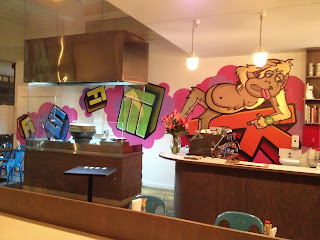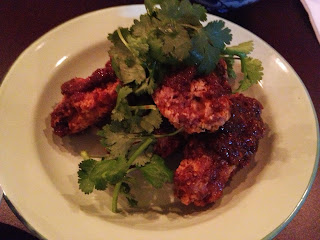230 Smith St, Collingwood, VIC 3066
http://masakmasak.com.au/
This is a funky place that thrives on simplicity. "Masak Masak" means 'To Cook", and in some cases in Malaysia, the term Masak Masak has a more playful informal connotation. It is more expensive that your average Malaysian cafe, more trendy, and has a contemporary feel in presentation. Note that they do close between lunch and 6pm (when they re-open again for dinner)
 |
| Grilling Station to the left |
 Simple deco with a big mural and basic chairs. The place can get noisy because sound insulation isn't great. There is a sense of space here from the way it's set up, though I suspect it will struggle to cope with big groups. The repetitive single reggae track drives me a bit nuts though. Finally, when they are grilling the satays and beef ribs - it gets pretty smokey inside. Parking on Smith Street is always going to be a problem but you could try Stanley Street around the corner.
Simple deco with a big mural and basic chairs. The place can get noisy because sound insulation isn't great. There is a sense of space here from the way it's set up, though I suspect it will struggle to cope with big groups. The repetitive single reggae track drives me a bit nuts though. Finally, when they are grilling the satays and beef ribs - it gets pretty smokey inside. Parking on Smith Street is always going to be a problem but you could try Stanley Street around the corner.Things to do Nearby: During the day, the Smith Street shops can be interesting a couple of blocks down, you have some of the outlets. During the night? Not so much.
The Food
 There is a range of modernised Malaysian dishes - they call it Malaysian hawker food with a twist. The Hainanese Chicken Rice (pictured left) is a serve and a half. There's probably about a third of a whole chicken in one servce. The white cut chicken is tender, on the bone and ever so slightly pink, much like the way it is served in Malaysia/Singapore. This is one of my favourite dishes here. Check out how much chicken there is!
There is a range of modernised Malaysian dishes - they call it Malaysian hawker food with a twist. The Hainanese Chicken Rice (pictured left) is a serve and a half. There's probably about a third of a whole chicken in one servce. The white cut chicken is tender, on the bone and ever so slightly pink, much like the way it is served in Malaysia/Singapore. This is one of my favourite dishes here. Check out how much chicken there is!
The Charcoal Grilled Beef Ribs (pictured below) are pretty tasty too, but the sambal oelek might not be to everyone's liking - it's a bit of an acquired taste if you have not have this style of sambal oelek before. The ribs on their own are pretty nice anyway - though it's not a dish for one person on its own (unlike the Hainanese Chicken Rice which can be shared or be eaten by one person (and a half)).
 |
| Possibly the most traditional dish on the menu other than Satay |
 |
| Buffalo Wings |
The Service
 |
| Lo Mai Gai (Sitcky Rice) was a little bit one dimensional for me |
The service here is really good and what is even more impressive is that they actually come round and see if you need anything during your meal. I asked for more soup and promptly got given more. They take time and make an effort to see how you are going without being intrusive. I think it provides better service than your average Malaysian joint... though I have to say the service at most Malaysian restaurants have improved remarkably over the year compared to some others.
Overall
I think it is a place I would go to once in a while to try out new dishes or for the Hainanese Chicken Rice. It doesn't have a huge range and for the traditionalists, this place is guaranteed to disappoint. However, for those who want to see what innovation might look like with Malaysian cuisine, this is worth checking out. Don't come here looking for the traditional dishes - they might have the same name - but that's about all. Cultural Moment
Sambals, Belachans, Cincalok are the various dipping sauces of Malaysia that usually contain some sort of preserved, or fermented seafood or vegetables. While various versions can be found all over South and Southeast Asia, I am just going to focus on the Malaysian ones here.
Belachan is fermented shrimp paste, which can be eaten with a squeeze of lime and fresh chillies, or fried till it's dark and dry, or used in stir fries. It can be fried up with shallots and garlic too and sprinked on dishes to add another layer of spiciness, or even stirred into soups (like laksa). Belachan is usually sold as a block that might look like a thick block or wedge of chocolate from a distance until you get a whiff of it.
Sambal is a chilli paste primarily and so, Sambal Belachan is chilli paste mixed with belachan, shallots, limes and sugar in various combinations. They can be used as an accompaniment to various dishes to given them an added 'kick'. In Sri Lanka (where you have Sambol) and Indonesia, there is a wide range of sambals that include a great variety of ingredients ranging from peanuts to bananas to petai (stinky beans) to anchovies.
Cincalok refers to a condiment that consists of shrimps fermenting in water, lime, shallots, and chillies. This is usually served wet, as dipping condiment, or the Peranakans love having it in omelettes (which I think is the best way to eat it because I can never take it on its own).
Chilli dipping sauces are also common in Malaysian Chinese cuisine, ranging from processed chilli sauces (which may be sweet or savoury or garlicky or super hot), to fresh cut chillies (green, red or padi) in vinegar or soy sauces, or ever preserved green chillies.

No comments:
Post a Comment